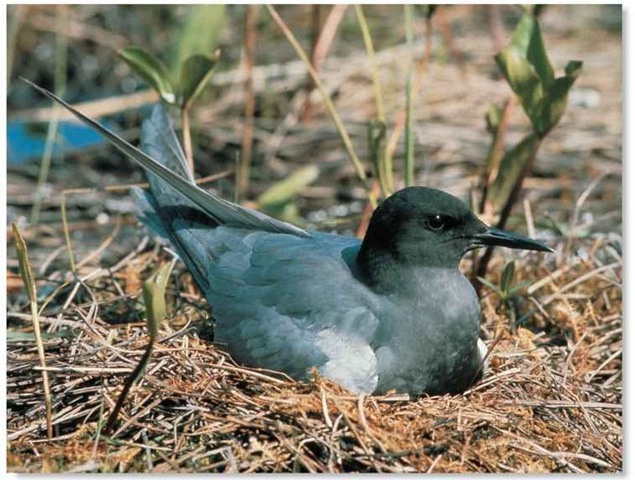ORDER
Charadriiformes
FAMILY
Sternidae
GENUS & SPECIES
key features
• This far-ranging tern has been known to feed up to 3 miles from its home colony
• Though it pursues aquatic prey, it also plucks insects out of midair with its sleek, black bill
• Often mistaken for a bat due to its erratic, dipping flight and dark coloring
where in the world?
Found in Scandinavia, Europe, western Asia and Africa; also in North America, as well as central and South America

LIFECYCLE
While its buoyant flight makes it look almost weightless, the feisty black tern makes a strong impression when it utters its prolonged, shrill scream to fend off intruders.
HABITAT
The black tern will live on virtually any wetland, including well-vegetated inland pools, lakes, peat bogs, rice fields, brackish marshes and even small ponds and ditches. The bird prefers sparse, open vegetation such as bulrush, cattail and, if available, floating water lilies.
Foraging over wetlands, but also in drier areas, black terns can often be found roosting on branches of downed trees or on pilings. In the colder winter months, large groups of black terns inhabit estuaries, coasts and coastal lagoons.
Hunting on the wing A large flock of terns flies over its watery habitat in search of aquatic prey.
Since the tern has lost much of its breeding habitat to wetland drainage, the U.S. Fish and Wildlife Service has considered listing it as threatened or endangered.
The tern will sometimes build its water-based nest on an already assembled muskrat home.
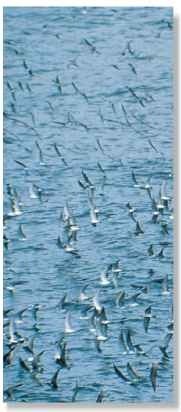
FOOD & FEEDING
A low-flying predator that prefers to feed mainly in the daytime, the black tern feasts on aquatic insects, small fish, snails, tadpoles and frogs, which make up the bulk of its extremely varied diet.When foraging, black terns constantly dip over water to snatch aquatic prey from the surface, but very rarely plunge into the water completely. The opportunistic birds are often seen close to the shore, feeding on small fish that have been forced to the surface by a pod of feeding dolphins. Instead of flying, the tern sometimes hunts from a perch high over water.
During the breeding season, the black tern prefers to feed insects to its nestlings. Tern favorites include dragonflies, moths, crickets and flies, which it captures by snatching them from the air.In fact, insects comprise over 90% of the food brought back to hungry nestlings.The tireless black tern zigzags back and forth after dragonflies in long pursuits that can last up to 10 seconds each. As it circles low over its various foraging areas with slow, shallow wingbeats and a downward-pointing bill, the gregarious black tern often congregates with other birds in large flocks where food is heavily concentrated.
► Mother hover A tern hovers above the nest while feeding her hungry nestlings.
fast food
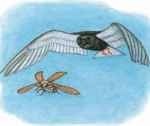
1 Cruise missile…
A cockchafer beetle is no match for the swiftly swooping black tern; the bird quickly snatches it with its sleek, black bill.
BEHAVIOR
Gregarious in nature, flocks of black terns may bathe together in extremely dense groups, also gathering in large flocks where there is a heavy concentration of food. During these interactions, the black tern’s call is a sharp klitt, or a short, nasal kja, which sounds quite clipped.The black tern is often mistaken for a bat or storm petrel, due to its erratic flight, frequent hovering and dark summer plumage. Although its feet are webbed, the black tern rarely settles on water when hovering in search of prey Despite its fragile, almost meek appearance, the black tern is suprisingly agressive: intruders are met with a shrill
► Tern twosome
scream, kreek or craik, and then Two terns take a break from quickly chased away. their constant hovering.
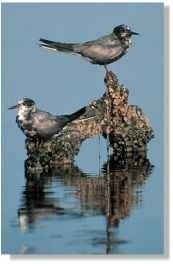

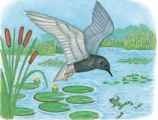
2 Dinnertime…
With the advantage of a “bird’s-eye view,” the tern spots a frog from far above the water and takes aim before descending.
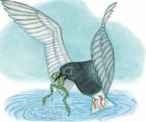
3 Unfair advantage…
The acrobatic tern swoops suddenly down to the water’s surface, easily capturing the unlucky frog in its bill.
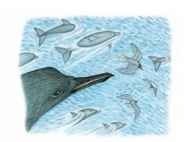
4 Tern teamwork
The tern takes advantage of a school of feeding dolphins: the mammals force small fish to the surface for an easy meal.
BREEDING
From May to August, black terns practice what is known as assortative mating, by which bird pairs are formed by size. Most colonies contain fewer than 20 breeding pairs, and rarely more than 100. The female makes her nest in a shallow depression by assembling masses of floating vegetation or selecting clumps of dead reeds or cattail root stalks.These water-based nests are usually found floating in shallow freshwater or brackish marshes. In her floating nest, the female tern lays from 2-4 eggs, which are pale brown with darker brown blotches. Incubation lasts for about 21-22 days and, within two short hours after hatching, the hungry chicks are fed their first meal. After about 25 days of feeding and care, the hardy chicks are ready to leave the nest.
conservation
The black tern is not globally threatened. In fact, some estimates of its world population run as high as 500,000 breeding pairs. However, many local populations are considered vulnerable and, sadly, appear to be on the decline.The main cause of the black tern’s apparent decline is the gradual loss of its freshwater marsh habitat for agricultural use or through the overgrowth of cattails. Pesticides are also believed to have played some role in the species’ decline, either through direct poisoning or by killing the aquatic prey that makes up the tern’s diet.
Nuzzling nestling A protective mother and her chick rest in the reeds.

PROFILE
Black Tern
With its short tail and wings, the black tern appears erratic and batlike in flight, often dipping to the water’s surface to pick up food with its bill.
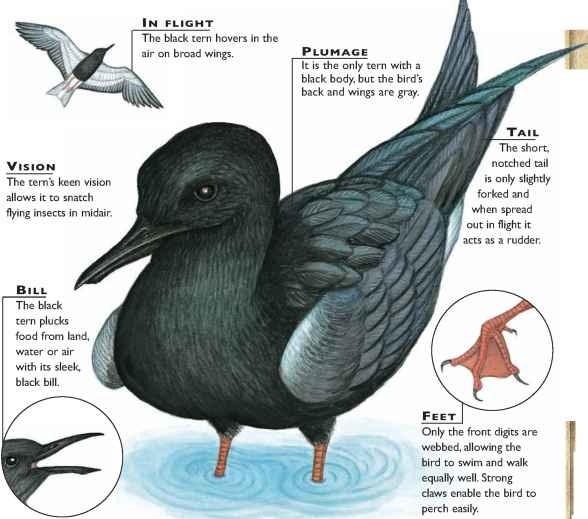
CREATURE COMPARISONS
The white tern (Gygis alba) is larger than the black tern, measuring ll-l3″.The only tern with all-white plumage, the white tern is a sharp contrast with its cousin’s dark to pale-gray plumage. While the black tern frequents inland pools, lakes and marshes, the white tern prefers coral islands, usually with vegetation.The white tern nests in trees, bushes and cliffs, where it lays its single egg directly on a tree branch;its cousin nests in a low mound of water weeds.The white tern ranges widely throughout the tropical and subtropical oceans;the black tern is found from southern Scandinavia to eastern Europe and western Asia to North, Central and South America.


| vital | |
| statistics | |
| Weight | 2-2.5 oz. |
| Length | 8.5-9.5″ |
| WlNGSPAN | 22.5-25.5″ |
| Sexual 2-4 years Maturity |
| Breeding .. Season | May-August |
| Number of Eggs | 2-4; usually 3 |
| Incubation Period | 21-22 days |
| Fledging Period | 21-28 days |
| Typical | Diet | Dragonflies, moths, crickets, flies, mollusks, small fish and other marine animals |
| Lifespan | Up to 17 years |
Related species
• The black tern is 1 of 3 species in the genus Chlidonias; the others are the white-winged tern, C. leucopterus, and the whiskered tern, C. hybridus. These terns join 41 other species in the family Sternidae, including the Sandwich tern, Thalasseus sandvicensis.Terns belong to the order Charadriiformes, which also includes gulls, skuas, jaegers and skimmers.
